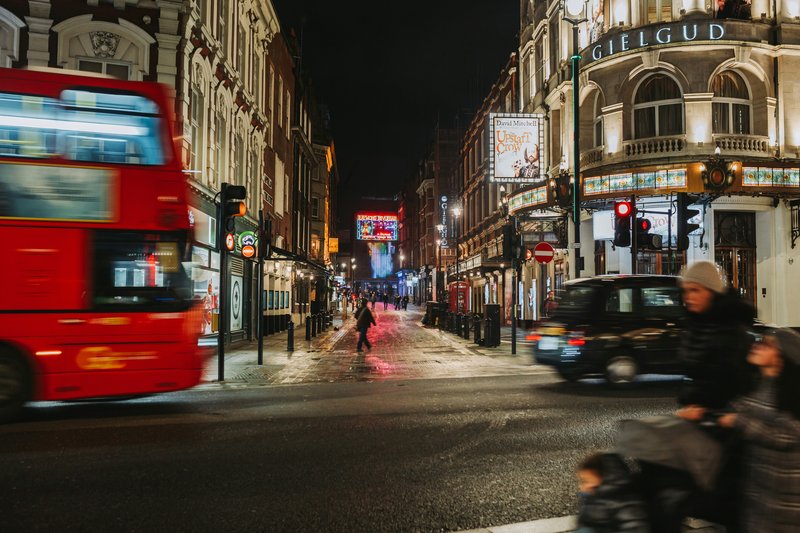You don’t need to be a Londoner to recognise that Shaftesbury Avenue is one of London’s most iconic streets; it’s the beating heart of the West End and a stage in its own right.
Stretching from Piccadilly Circus to New Oxford Street, it’s probably best known for its glittering theatres and neon lights, but behind the curtain lies a fascinating history few people know.

From Victorian engineers and sewer saviours to martial arts masters and music legends, Shaftesbury Avenue has truly seen it all.
Read on to uncover some surprising facts about Shaftesbury Avenue that reveal its hidden past, colourful characters and dramatic moments that have helped shape London’s cultural landscape!
Fancy Exploring the West End?

Explore London’s West End on Race Across The World: The Experience Christmas Edition
Step into a festive adventure in the West End with the latest Race Across The World experience!
Like the original, the race takes place over three legs filled with puzzles, challenges, and budget-management decisions.
In this festive edition, however, you’ll bundle up and dash through Covent Garden, Mayfair, Soho and beyond on a Christmas-themed quest to track down the guest book, and see some of the West End’s most glorious Christmas lights as you go.
Important Info: You must be 18+ to purchase tickets. The experience is designed to be accessible and inclusive. See FAQs for details.
1. It Was Partially Designed By The Man Who Solved London’s Sewer Problems
Before Shaftesbury Avenue became synonymous with showbiz, it was just another job for an ambitious Victorian civil engineer.
Sir Joseph Bazalgette, the visionary behind London’s revolutionary sewer system, helped design this grand boulevard in the 1870s. It was his job to design a clever system that would bring light, air and traffic relief to some of the city’s most overcrowded and disease-ridden slums.
Unfortunately, the beacon of Bazalgette’s signature genius at Shaftesbury Avenue lies underground: the 1880s construction included a continuous utility subway beneath the avenue to carry gas, water and other services.
2. It’s Home to The First Commercial Asian Martial Arts School in The Western World
Long before London’s fitness craze and boutique boxing gyms, Shaftesbury Avenue hosted a secret dojo beneath No. 67.
Between 1899 and 1902, the Bartitsu Club taught Victorian gentlemen how to defend themselves with jujitsu, boxing, and even cane-fighting. The founder, Edward Barton-Wright, dubbed it a “gentlemanly art of self-defence.”
It later earned immortality in Sherlock Holmes, when Sir Arthur Conan Doyle had the detective casually mention his mastery of “baritsu”, a typo that still resonates today!
3. The Land It Crosses Was Once Known as Kemp’s Field
Do you ever imagine what London was like before it became this busy? Incredible though it seems to us today, before theatres and taxis, there were haystacks and pastures.
According to one newspaper article, The Bioscope, the land beneath Shaftesbury Avenue was once called Kemp’s Field and was little more than a quiet green stretch on the edge of London’s early expansion.
As the city grew, it became Kemp’s Court and eventually became part of the bustling West End we know and love today.

4. Yusuf Islam (Cat Stevens) Lived There as a Child
Not many humble beginnings don’t begin on Shaftesbury Avenue these days, but it wasn’t always a ritzy and expensive address.
Long before Wild World and Father and Son made him a global star, a young Steven Demetre Georgiou, later known as Cat Stevens, and later still as Yusuf Islam lived on Shaftesbury Avenue.
His family owned a restaurant on the street where the young Cat spent a chunk of his childhood. Incredibly, years later, he ended up performing just down the road from his old home.
5. It’s Named After A Man Who Was Once the Vice-President of The RSPCA
There’s a lot to be said about the 7th Earl of Shaftesbury, or Anthony Ashley-Cooper, as he was also known.
A Victorian philanthropist, Anthony Ashley Cooper campaigned for factory reform, child welfare, and even animal rights.
As vice-president of the RSPCA and president of countless social causes, he was the kind of man who made compassion fashionable.
6. In 2013, The Ceiling of The Apollo Theatre Once Collapsed During a Performance
During a 2013 performance of The Curious Incident of the Dog in the Night-Time, a section of the Apollo Theatre’s ornate plaster ceiling suddenly gave way. Dust, debris, and panic filled the air, though, remarkably and thankfully, there were no fatalities.
The show quite literally stopped, but London’s theatre spirit didn’t: the production reopened weeks later, proving the old adage that the show must, indeed, go on.
7. Two of Shaftesbury Avenue’s Corner Theatres Are “Twins” by W. G. R. Sprague
Architect W. G. R. Sprague left his theatrical fingerprints all over Shaftesbury Avenue, but none more cleverly than his twin theatres: the Globe and the Queen’s.
If these names aren’t familiar to you, they will be soon. Built in matching style at opposite ends of the street, they bookend the avenue. They were later renamed the Gielgud and the Sondheim in honour of two legends of stage and song.
Find More Things to Do in London with CityDays

Whatever your interests are, there’s always something new for you to discover in London.
In fact, you don’t have to go out of your way at all to find them - you just have to know where to look.
Discover London’s secret sights and noteworthy nooks by playing one of our London treasure and scavenger hunts, food experiences, escape room games or walking tours.
Looking to provide the best team building activities in London? Look no further.
You’ll find curated trails and hunts all over London, including Central London, Mayfair, Shoreditch, Kensington and Southwark.
The best part? We’ll recommend top-rated pubs, cafés and restaurants and give your team the chance to earn rewards by competing on our leaderboard.